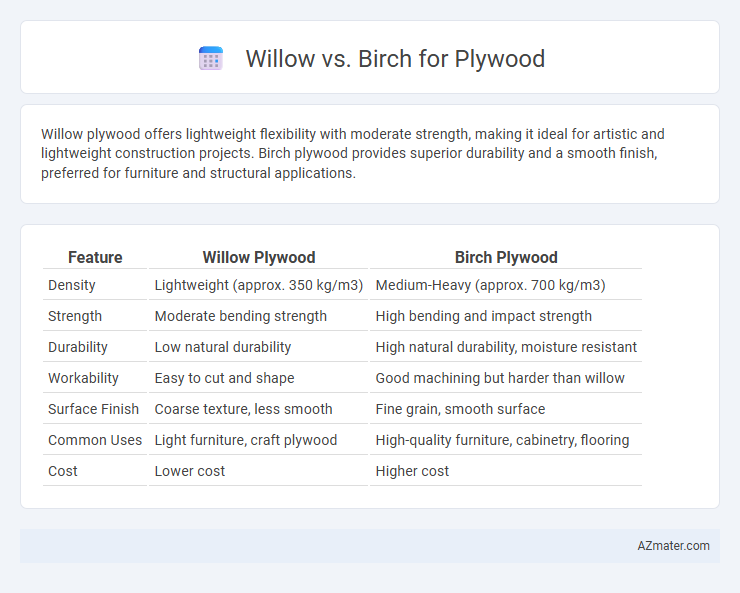Willow plywood offers lightweight flexibility with moderate strength, making it ideal for artistic and lightweight construction projects. Birch plywood provides superior durability and a smooth finish, preferred for furniture and structural applications.
Table of Comparison
| Feature | Willow Plywood | Birch Plywood |
|---|---|---|
| Density | Lightweight (approx. 350 kg/m3) | Medium-Heavy (approx. 700 kg/m3) |
| Strength | Moderate bending strength | High bending and impact strength |
| Durability | Low natural durability | High natural durability, moisture resistant |
| Workability | Easy to cut and shape | Good machining but harder than willow |
| Surface Finish | Coarse texture, less smooth | Fine grain, smooth surface |
| Common Uses | Light furniture, craft plywood | High-quality furniture, cabinetry, flooring |
| Cost | Lower cost | Higher cost |
Introduction to Willow and Birch as Plywood Materials
Willow and birch are popular choices for plywood due to their unique wood properties and availability. Birch plywood is known for its strength, fine grain, and smooth finish, making it ideal for high-quality furniture and cabinetry. Willow plywood offers a lightweight and flexible option, suitable for applications needing maneuverability and moderate durability.
Botanical and Structural Differences
Willow plywood, derived from Salix species, features softer fibers and lower density, resulting in a lighter but less durable sheet compared to birch plywood, which comes from Betula species known for tight grain and high density. Birch plywood offers superior strength, resistance to warping, and a smooth surface ideal for cabinetry and furniture, while willow's flexibility suits applications requiring lightweight and pliable materials. Structurally, birch's dense cellular arrangement provides enhanced load-bearing capacity, contrasting with willow's porous anatomy that contributes to its elasticity but reduces overall rigidity.
Wood Grain and Aesthetic Appeal
Willow plywood features a subtle, fine-grain texture that provides a uniform and smooth surface ideal for modern, minimalist designs. Birch plywood exhibits a tight, straight grain pattern with a pale, creamy color that enhances its natural warmth and makes it highly versatile for both traditional and contemporary aesthetics. The choice between willow and birch plywood ultimately depends on the desired grain visibility and overall visual appeal in woodworking projects.
Mechanical Strength and Durability
Willow plywood offers moderate mechanical strength with good flexibility, making it suitable for lightweight applications but less ideal for load-bearing structures. Birch plywood exhibits superior mechanical strength characterized by high density and consistent grain, resulting in excellent durability and resistance to wear over time. The dense hardwood properties of birch make it the preferred choice for furniture and flooring where long-term performance under stress is critical.
Workability and Machining Properties
Willow plywood offers excellent workability due to its lightweight and fine grain structure, allowing for smooth cutting and shaping with minimal splintering. Birch plywood is renowned for superior machining properties, providing a consistent density that holds screws and nails securely while maintaining clean edges during routing and drilling. Both species deliver reliable performance, but birch often excels in precision applications requiring high durability and finish quality.
Moisture Resistance and Stability
Willow plywood offers moderate moisture resistance but tends to absorb water more quickly, which can lead to swelling and reduced dimensional stability over time. Birch plywood provides superior moisture resistance and maintains higher structural stability due to its dense grain and tighter cell structure, making it ideal for applications exposed to humidity. Stability in birch plywood minimizes warping and delamination, enhancing its durability compared to willow under varying moisture conditions.
Cost and Availability Comparison
Willow plywood is generally more affordable due to the faster growth rate and abundant supply of willow trees, making it a cost-effective option for budget-conscious projects. Birch plywood, while pricier, offers superior durability and a finer grain, with availability dependent on regional sourcing, often leading to higher market prices in areas where birch is less common. Both materials have consistent availability in North American and European markets, but willow's rapid renewability gives it an edge in cost efficiency and sustainable sourcing.
Common Applications in Plywood Manufacturing
Willow plywood is prized for its lightweight and flexible properties, making it ideal for applications such as lightweight furniture, paneling, and craft projects requiring ease of shaping. Birch plywood is favored for its high strength, durability, and smooth surface, commonly used in flooring, cabinetry, and structural components where robustness and a clean finish are essential. Both types offer unique advantages, with willow suited for flexibility-driven applications and birch preferred for high-performance and aesthetics in plywood manufacturing.
Environmental Impact and Sustainability
Willow plywood offers rapid renewable resource benefits due to its fast growth rate, resulting in lower carbon emissions and enhanced carbon sequestration compared to birch. Birch plywood, while denser and durable, involves longer growth cycles, leading to potentially higher environmental footprints and slower forest regeneration. Selecting willow for plywood supports sustainable forest management and reduces deforestation concerns, making it a preferred eco-friendly choice in sustainable construction and manufacturing.
Which Is Better: Willow or Birch for Plywood?
Birch plywood is better than willow for plywood due to its superior strength, durability, and consistent grain structure, making it ideal for furniture and cabinetry. Willow plywood lacks the hardness and stability found in birch, resulting in lower resistance to wear and deformation. For applications requiring structural integrity and smooth finishing, birch plywood offers enhanced performance and longevity compared to willow.

Infographic: Willow vs Birch for Plywood
 azmater.com
azmater.com